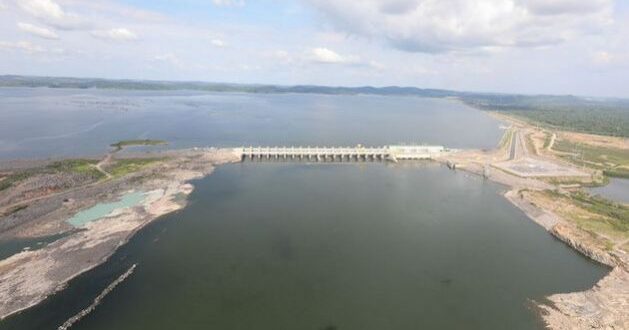RIO DE JANEIRO, Dec 28 (IPS) – “We’re now not aware of the Xingú River,” whose waters govern “our lifestyle, our revenue, our meals and our navigation,” lamented Bel Juruna, a younger indigenous chief from Brazil´s Amazon rainforest.
“The water is now not at its regular, pure stage, it’s managed by the floodgates,” she defined. The large floodgates are managed by Norte Energia, a public-private consortium that owns the Belo Monte hydroelectric plant whose curiosity is utilizing the river circulation for revenue.
Constructed between the center and decrease sections of the Xingú River, within the jap Amazon, Belo Monte takes benefit of a 130-kilometre U-shaped curve within the river, referred to as the Volta Grande.
A 20-km synthetic channel diverts many of the circulation, in a shortcut that connects to the top of the curve, at an 87-metre waterfall. The shortcut saved the Volta Grande – the place there are 25 communities, together with two legally protected indigenous territories – from flooding.
The brand new undertaking changed the preliminary concept courting to the 1970s – which might have created a traditional 1,225-square-kilometre reservoir that will have submerged your complete Volta Grande – with two smaller reservoirs totalling 478 sq. kilometres. The primary retains water earlier than the curve and diverts it to the channel that varieties the reservoir that feeds the primary energy plant, which produces 11,000 megawatts of electrical energy.
The second dam, with a plant that generates as much as 233 megawatts, holds the floodgates that launch water into the Volta Grande, which just about dried up, bringing different sorts of impacts for the riverbank inhabitants.
The Belo Monte advanced, with the third largest energy plant on the planet, is deliberate to generate simply four,571 megawatts of agency vitality on common.
This low stage of productiveness, of solely 40 p.c of put in capability, is defined by the truth that it’s a run-of-river plant whose circulation varies from greater than 20,000 cubic metres per second within the wet season – which lasts a number of months within the first half of the yr – to lower than 1,000 metres per second in a number of the driest months.
The waters of the river, divided between its pure course and the channel, proved to be inefficient when it got here to sustaining the extent of electrical energy technology meant by Norte Energia and the vitality authorities and on the similar time assembly the very important wants of the folks of the Volta Grande.
“We now not know methods to navigate the Xingú River, which channels to move by, as a result of Belo Monte closes and opens the floodgates every time it desires to,” mentioned Bel, a member of the indigenous folks referred to as Juruna, who name themselves Yudjá, which implies “the indigenous folks of the river.”
The Xingú, one of many largest Amazon tributaries, 1,815 kilometres in size, is especially tough in its center part, with many seen and submerged rocks, islands and islets, and each deep and shallow channels. Navigation is harmful and requires sensible data and familiarity, which have been thrown into chaos by the low water ranges and the adjustments within the pure low and high-water cycles.
“We wish sufficient water to flood the ‘igapós’ (blackwater swamp forests seasonally inundated with freshwater) the place fish and turtles can breed and feed in the course of the winter, to fatten up and preserve their weight in the summertime,” demanded Bel, who took her ethnic group’s identify as her surname, a typical customized amongst indigenous folks in Brazil.
Fish and the yellow-spotted river turtle (Podocnemis unifilis), a species of freshwater turtle considerable within the Amazon, are vital sources of protein for the folks of the Volta Grande, particularly the Juruna folks, fisherpersons and individuals who work on boats.
“However it’s life itself that’s in danger, not simply us indigenous folks; it’s nature that’s disadvantaged of the water cycle – the bushes, the fish and different animals,” Bel instructed IPS in a Whatsapp dialogue from her village, Miratu, on the left financial institution of the Volta Grande.
The wrestle of the Juruna folks, which they are saying they’re waging for humanity as an entire, was given a lift due to a brand new evaluation by the federal government’s environmental company, IBAMA, in December 2019.
The company acknowledged that the scant water launched by the hydroelectric plant doesn’t guarantee “the copy of life” within the Volta Grande ecosystem or “the survival of the native inhabitants.”
For that purpose, IBAMA desires to extend the water within the “decreased circulation part”, the place it’s about 20 p.c of the earlier regular circulation as outlined within the so-called “consensus hydrograph”, which defines the month-to-month flows within the river’s pure channel, based mostly on what was thought of essential to maintain the ecosystem alive in 2009.
Citing knowledge analysed since 2015, when Belo Monte stuffed its reservoirs, Ibama technicians pointed to the necessity for a greater distribution of water between the manufacturing of electrical energy and the sustenance of life.
Ibama’s environmental analysts beneficial a provisional hydrograph for this yr with a significant enhance in quantity for the Volta Grande within the interval from January to Could, particularly in February (from 1,600 to 10,900 cubic metres per second), March (from four,000 to 14,200 m3/s) and April (from eight,000 to 13,400 m3/s).
For the long run, Norte Energia is to current research to create a definitive hydrograph.
However the prime officers in IBAMA delayed the proposed measures, and after that the corporate challenged them in courtroom. It misplaced within the first and second occasion and didn’t adjust to the calls for in pressure in October and November.
The legal professional basic’s workplace determined to intervene and ordered IBAMA to draft sanctions in opposition to Norte Energía for non-compliance with the provisional hydrograph, the flows required for 2021 to implement the precautionary precept, and measures to make sure that the corporate carried out the complementary research to create the long-term hydrograph.
A powerful water circulation within the first months of the yr and “for no less than three months” is critical for fish and turtles to have the ability to breed and feed, mentioned Juarez Pezzuti, a professor of biology on the Federal University of Pará who’s an skilled on turtles.
“Rising the circulation solely in April shouldn’t be an answer. It’s important to have a quantity of water that floods in depth forest areas, to the required stage and on the correct time, for instance, for the larvae to turn out to be fry and for the meals chain to develop usually,” he defined to IPS by cellphone from Ananindeua, the place he lives, within the Amazonian state of Pará.
For all times alongside the Xingú River, extra critical than extreme droughts within the dry season, or “summer time” within the Amazon, is “a low stage of rainfall within the winter,” he mentioned.
The battle is going through an important second, as a result of the actions taken by IBAMA – surprising below the far-right authorities of President Jair Bolsonaro, which has labored in opposition to environmentalism – have been opposed by the ability trade’s regulatory company and by the Ministry of Mines and Power, which declare that modifying the hydrograph would trigger vitality insecurity and better prices for customers.
Pezzuti believes that regardless of the end result of this dispute, Belo Monte is doomed to face growing difficulties when it comes to financial viability because of the worsening of droughts within the Xingú basin brought on by local weather change and intense deforestation upstream.
The disaster of 2016, when the Juruna indigenous folks complained that there have been fewer and fewer fish and that they have been “skinny” because of the drought brought on by the El Niño climate phenomenon, was a warning for the long run, he mentioned.
Because the approval of the mega hydroelectric undertaking in 2009, quite a few critics, together with environmental authorities, indigenous folks, college researchers and vitality specialists, have warned in regards to the dangers of the enterprise itself, along with the social and environmental injury.
The undertaking, which was inaugurated on Nov. 27, 2019, as soon as the 18 producing items of the primary plant have been accomplished, has been extremely praised for the progressive channel. But it surely turned out to be a misleading answer, each for the corporate and for the affected inhabitants, which has suffered irreversible injury.
“For the Juruna folks, the influence shouldn’t be solely on meals, however there has additionally been a heavy influence on our tradition, which is fishing, taking good care of the river that gives meals, revenue and navigation to go to the cities, go to neighbouring communities and have enjoyable. It’s what brings pleasure to our lives,” mentioned Bel Juruna.
© Inter Press Service (2020) — All Rights ReservedOriginal source: Inter Press Service
 Top Naija News – Nigeria News, Nigerian News & Top Stories Top Naija News – Nigerian Newspapers, Nigerian News. topnaijanews is a daily Nigerian newspaper covering Latest News, Breaking News, Entertainment, Sports, Lifestyle and Politics.
Top Naija News – Nigeria News, Nigerian News & Top Stories Top Naija News – Nigerian Newspapers, Nigerian News. topnaijanews is a daily Nigerian newspaper covering Latest News, Breaking News, Entertainment, Sports, Lifestyle and Politics.




